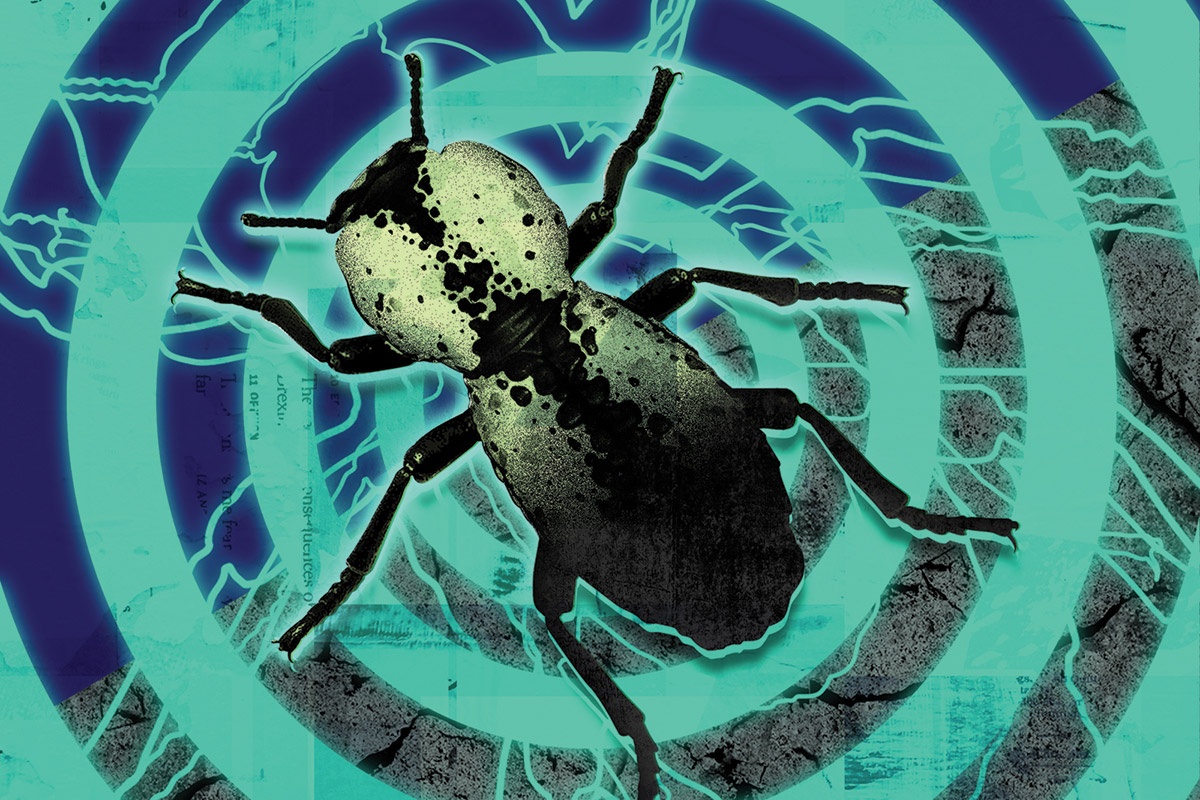My heart sank. A tiny form lay motionless at the watery bottom of a metal bucket I kept under our air conditioner’s drain line. I plunged my hand into the water and scooped up the lifeless thing.
“Oh, you poor baby,” I murmured, right away recognizing that I’d brought up a Texas ironclad beetle. “I’m so sorry.” Gently, I laid the insect on a nearby rock. I nudged the beetle’s body with my index finger. No response. Not even a twitch from a mangled leg. Darn, the bucket had claimed yet another casualty. Or had it?
This amazing species ranks high among my beetle favorites. An inch or so long, the Texas ironclad beetle (Zopherus nodulosus haldemani) can be found across Central and East Texas and into northeastern Mexico. It poses no threat to you or your garden. The markings on its top side remind me of an inkblot personality test. After comparing the spots of numerous ironclads, I would venture to say that, like snowflakes, no two are exactly the same.
Surprisingly, an ironclad’s striking coloration actually blends in well with tree bark, where biologists believe the beetle begins its life cycle as an egg laid in a crevice. I found little information about the ironclad’s larval and pupal stages. Adults feed on lichens and fungi that grow on oak, elm and pecan bark.
Though I’ve never tested this characteristic (nor will I ever), the ironclad’s external shell is extremely hard, hence its name. Collectors who pin insects for display know this firsthand. Ask some, and they’ll explain how they have to drill a small hole into a dead ironclad’s wing before they can insert a pin. (Yes, beetles have wings, and many can fly. But not ironclads—their wings are fused shut.)
I was impressed when I read how the ironclad’s nearly indestructible shell and flexible six legs inspired engineers with BAE Systems to build a prototype suspension for combat vehicles. That system, developed in 2016, uses a bendable titanium alloy. After suffering an explosion, the alloy can pop back into shape.
This hardy insect can deploy another survival tactic. Many’s the time I’ve picked up an ironclad beetle, only to have it curl up its black legs and play dead. Its black pair of clubbed antennae even disappear by tucking into little recesses on its head, thus protecting those sensitive appendages. Once, I startled an ironclad, and it immediately froze into a dead position with its legs crisscrossed. Once the beetle feels safe, it unfolds its legs and continues on its way. The death-feigning ability, performed by many organisms when threatened, is called thanatosis.
When I returned to check on my waterlogged beetle, I found a living ironclad beetle, ambling around the bucket. I searched for the deceased ironclad but could not find a carcass. This led me to believe that my beetle had avoided a watery demise. I rejoiced and relocated Lazarus, as I christened him, to a shrub in our backyard. Had my beetle really come back to life after drowning?
That happened in October 2015. Now fast forward to August 2018, when I spotted a lifeless ironclad beetle at the bottom of an orange bucket that I now keep under the same AC drain line. The beetle had likely been submerged all night. With sadness, I retrieved it and laid it on a plaid pillowcase in our garage. With its legs folded up and its antennae tucked out of sight—and its normally bright white hue turned blackish gray—my friend certainly looked dead. Feeling hopeful, I was determined to document what I observed.
Gradually, the beetle’s bright white color returned. Its legs opened, and its antennae reappeared. While I snapped photos, Lazarus 2, beautifully patterned and vibrantly alive, clambered around.
Hallelujah!
I snooped around for scientific studies that would explain my beetle’s miraculous recovery. I couldn’t find any. Based on related studies, possible explanations include: Some beetles can either slow down their metabolism while immersed or they can store oxygen beneath their wings. As for the shell’s bluish black color in “death” and return to normalcy when revived, I’m stumped.
A week after Lazarus 2, I found a third ironclad at the bottom of a bucket. This time, I took a photo to prove I’d found a drowned beetle at the bottom of a water-filled bucket. Then I fished it out. Like the two others before, its bright white hue had turned blackish. Poor thing.
This one’s normal color returned more quickly. Still, the beetle seemed door-knob dead—until I nudged one leg, and it moved. With my smartphone, I shot a brief video of the beetle slowly reviving. “He’s alive!” I exclaimed off camera. Miracle or not, I rejoiced yet again.
Blanco writer Sheryl Smith-Rodgers plans to add a screened cover to the bucket.


